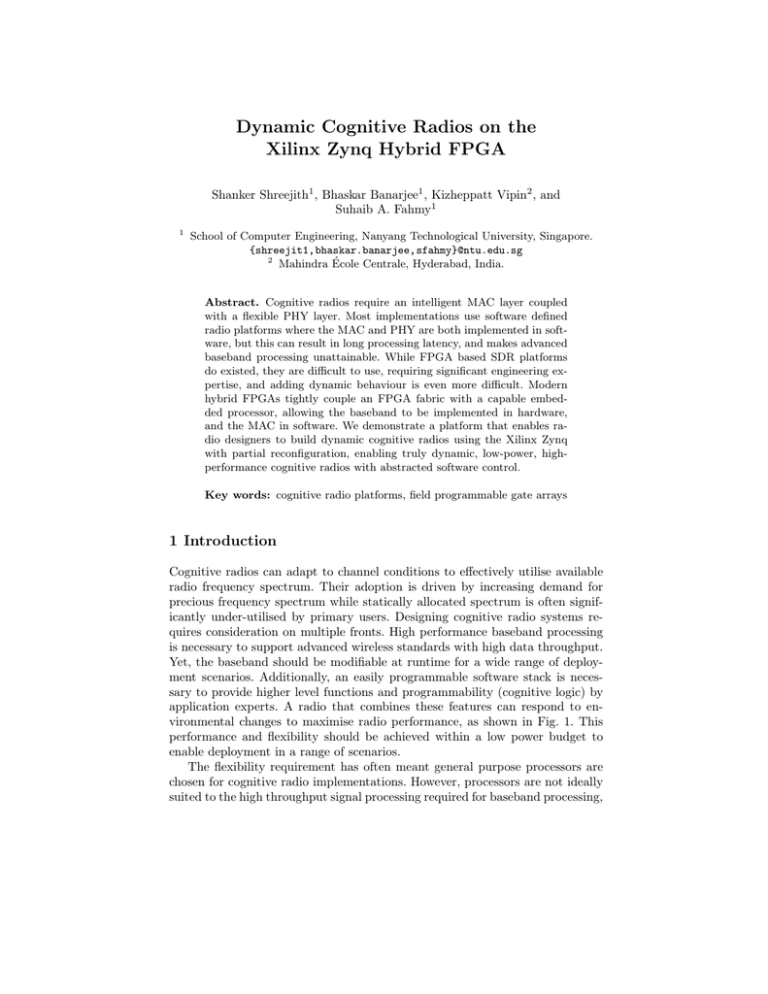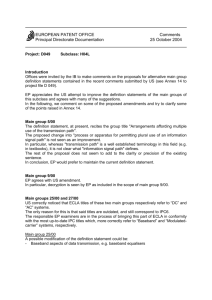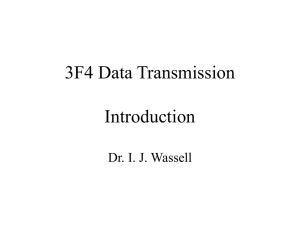Dynamic Cognitive Radios on the Xilinx Zynq Hybrid FPGA Shanker Shreejith
advertisement

Dynamic Cognitive Radios on the
Xilinx Zynq Hybrid FPGA
Shanker Shreejith1 , Bhaskar Banarjee1 , Kizheppatt Vipin2 , and
Suhaib A. Fahmy1
1
School of Computer Engineering, Nanyang Technological University, Singapore.
{shreejit1,bhaskar.banarjee,sfahmy}@ntu.edu.sg
2
Mahindra École Centrale, Hyderabad, India.
Abstract. Cognitive radios require an intelligent MAC layer coupled
with a flexible PHY layer. Most implementations use software defined
radio platforms where the MAC and PHY are both implemented in software, but this can result in long processing latency, and makes advanced
baseband processing unattainable. While FPGA based SDR platforms
do existed, they are difficult to use, requiring significant engineering expertise, and adding dynamic behaviour is even more difficult. Modern
hybrid FPGAs tightly couple an FPGA fabric with a capable embedded processor, allowing the baseband to be implemented in hardware,
and the MAC in software. We demonstrate a platform that enables radio designers to build dynamic cognitive radios using the Xilinx Zynq
with partial reconfiguration, enabling truly dynamic, low-power, highperformance cognitive radios with abstracted software control.
Key words: cognitive radio platforms, field programmable gate arrays
1 Introduction
Cognitive radios can adapt to channel conditions to effectively utilise available
radio frequency spectrum. Their adoption is driven by increasing demand for
precious frequency spectrum while statically allocated spectrum is often significantly under-utilised by primary users. Designing cognitive radio systems requires consideration on multiple fronts. High performance baseband processing
is necessary to support advanced wireless standards with high data throughput.
Yet, the baseband should be modifiable at runtime for a wide range of deployment scenarios. Additionally, an easily programmable software stack is necessary to provide higher level functions and programmability (cognitive logic) by
application experts. A radio that combines these features can respond to environmental changes to maximise radio performance, as shown in Fig. 1. This
performance and flexibility should be achieved within a low power budget to
enable deployment in a range of scenarios.
The flexibility requirement has often meant general purpose processors are
chosen for cognitive radio implementations. However, processors are not ideally
suited to the high throughput signal processing required for baseband processing,
2
S. Shreejith et al.
Event
Cognitive
Logic
Cognitive
Logic
Reconfigure
t2
Data
t1
Baseband
t3
Data
t2
t4
t1
t3
Baseband
Adaptation
Fig. 1. Baseband adaptation under the control of software cognitive logic, in response
to an external event.
and as a result, experimental radios are often implemented on fully-functional
desktop computers that consume significant power, precluding deployment in
scenarios with restricted power, space, and portability requirements. As a result
much cognitive radio systems research has been restricted to investigations in
labs.
Field programmable gate arrays (FPGAs) have been used for signal processing for over two decades. They enable highly advanced baseband systems to be
implemented within a low computational power budget, by exploiting the finegrained parallelism found in such algorithms. FPGAs are also volatile devices
that can be reprogrammed with different functionality at runtime. However,
designing FPGA based systems has remained difficult for non-experts.
Recently, new platforms have emerged that couple high performance embedded processors with a flexible FPGA fabric on a single die. In such systems,
the processor can host a fully functioning software stack while the baseband
can be implemented in the reconfigurable fabric, with high throughput connectivity between them. This represents a promising platform for cognitive radio
systems, offering both high computational performance and flexibility that can
be leveraged from higher software layers.
We have developed a prototyping system incorporating the Xilinx Zynq hybrid FPGA, allowing us to combine software programmability for upper layers of
the radio with a high-performance flexible baseband implemented in hardware.
The software portion of the radio has full control of baseband configuration, and
we have abstracted control to enable radio experts to leverage advanced features
like FPGA partial reconfiguration. In this paper, we present our platform and
a case study, before characterising its dynamic properties. We show that with
the proposed abstraction layer, it is possible to bring together the flexibility of
software control with the performance of a hardware baseband.
Dynamic Cognitive Radios on the Xilinx Zynq Hybrid FPGA
3
2 Background and Related Work
Modern radio protocols rely on flexibility to make efficient use of limited communication spectrum, resulting in the need for highly adaptable baseband and RF
processing systems. Research on cognitive radio platforms has focussed primarily
on software platforms with component level architectures to afford flexibility as
in the case of GNU Radio [1] and Iris [2]. The use of software enables dynamic
configurability of the baseband, coupled with an easily programmable MAC
layer. While these platforms have been useful for prototyping and academic research, the overhead of implementing advanced baseband processing in software
running on general purpose processors means prototyping advanced systems is
unrealistic.
Field programmable gate arrays (FPGAs) are silicon devices with a programmable architecture that is flexible enough to implement arbitrary custom
datapaths [3]. To implement a datapath circuit, the designer describes it using a hardware description language like Verilog. This design is synthesised and
converted, using vendor tools, to a set of configurations that describe how the
basic components are to be set up. This “bitstream” is loaded into the FPGA
configuration memory to implement the described circuit. As FPGAs are ideally suited to parallel algorithms with large amounts of regular computation,
they have been widely used in software radio systems [4]. What makes modern
FPGAs attractive for cognitive radios is that besides the high performance of a
static datapath implementation, they offer flexibility too.
Multiple radio test beds have leveraged FPGA capabilities for acceleration,
like the WARP project from Rice University [5] and the SDC Testbed from
Drexel [6]. Iris [2] was also extended with FPGA baseband processing support [7],
demonstrating the ability to minimise power consumption in the baseband as
channel conditions change [8]. KAUR [9] closely couples a general purpose processing platform, a Xilinx Virtex-II Pro FPGA, and RF front-end in a compact
form factor with software and hardware API functions for managing computation. CRUSH [10] integrates a Xilinx Virtex 4 platform with GNU Radio and
the USRP front end, offering the performance benefits of a custom baseband
datapath, but none of the programmability benefits of FPGAs. CRKIT [11] also
aims at integrating hardware baseband processing with software radio management in a system-on chip on an FPGA. It hosts multiple hardware baseband
processing chains with support for switching between them and adapting parameters at run-time. Fundamentally, these platforms do offer the performance
benefits of hardware, but in many cases, these are limited by the latencies of
software-hardware communication due to distinct subsystems being used for the
two components, or outdated embedded processor integration on older FPGAs.
Beyond performance, FPGAs offer the advantage of flexibility as they can
be reprogrammed with different hardware depending on requirements. Partial
Reconfiguration (PR) is an advanced technique that allows parts of the hardware
to be modified at runtime while other parts continue to run, enabling designers
to swap modules at any given time. Though PR provides adaptability and power
savings, it requires explicit management of reconfiguration and synchronisation,
4
S. Shreejith et al.
External
Control
Cognitive
Functions
Control plane Data-plane
Status
Data plane
Tx/Rx
t1
Data-plane
Control
t2
t3
RF
Fig. 2. Conceptual view of intelligent cognitive radio separated into control and data
planes.
which is difficult in heterogeneous radio systems. Designing efficient PR systems
is non-trivial and is an area explored only by FPGA experts. Iris has explored
the use of partial reconfiguration, but the software portions of the radio are
deployed on a PowerPC hard processor on the Virtex 5 FPGA, resulting in low
performance [8]. Furthermore, the use of soft and hard processors in FPGAs
remains difficult for anyone other than FPGA designers.
In this paper, we present a radio platform based on the hybrid Xilinx Zynq
FPGA that offers a strongly integrated processing system and reconfigurable fabric. It enables low latency data movement and close integration between higher
layers of the radio stack and the computational baseband processing with predicable performance. In [12], the authors showed that the tight coupling and predictable latency afforded by moving even MAC layer functions into hardware can
improve radio performance. We believe hybrid FPGAs offer an ideal architecture
for integrating the computational capabilities of hardware processing with high
level management of dynamic radio behaviour. However, design complexity must
be addressed if such platforms are to be adopted by the radio community. The
team behind Iris demonstrated an initial attempt at using the Zynq processor
to run a radio management system, but with no hardware support [13].
We present the first platform to demonstrate interacting software on the
ARM processor and a reconfigurable hardware baseband in programmable logic
on the Xilinx Zynq. We abstract the low-level baseband management operations,
allowing the software radio designer to use high-level function calls to cause
parametric and structural reconfiguration of the baseband, simplifying the management process. Our platform integrates a high speed partial reconfiguration
controller to allow reconfiguration of the radio baseband with very low latency.
3 System Architecture
Intelligent cognitive radio designs can be conceptualised as two independent
planes, as shown in Fig. 2: the data plane which performs the baseband mod-
Dynamic Cognitive Radios on the Xilinx Zynq Hybrid FPGA
5
ulation/demodulation and the control plane that performs radio control functions; the cognitive part. In essence, the control plane implements medium access
schemes, enabling the same channel to be used by multiple devices with collision
avoidance or detection, and higher layer protocols that ensure reliable transmission. With cognitive radios, the control plane takes on more complex tasks
like monitoring channel conditions, triggering sensing, and modifying the configuration of the baseband in response to varying conditions, e.g., by switching
the modulation scheme, modifying coding, or changing the baseband transmission standard entirely. The data plane responds to such requests by altering its
functions, and should hence support all required types of signal processing to
support the various possible modes the system may operate in.
The control plane may use complex intelligent algorithms. Ideally, this cognitive part of the radio should offer maximum flexibility, easy programmability,
and being control-intensive, is suited to implementation in software running on a
processor. The data plane, however, deals with heavy computational processing
on streams of data samples, and so when implemented in software, suffers from
long computational latency, and a reliance on powerful processors for advanced
baseband schemes or radio standards.
We propose that the strength of FPGAs in data processing be leveraged as
in the case of some of the platforms discussed in Section 2, and the data plane be
implemented in custom hardware. The key novelty in our platform is to enable
dynamic modification of the data plane from the control plane without the need
for detailed FPGA knowledge. Previous attempts at building such platforms
have used software running on a soft processor on the FPGA fabric with the
data plane also in the FPGA as custom hardware blocks, but radio control
and reconfiguration still required low-level FPGA knowledge. Essentially, the
designer would need to prepare a set of valid hardware configurations for the
data plane, store this configuration information in off-chip memory, then manage
the loading of the required configurations at runtime through the low-level driver
provided by the FPGA vendor. This meant that only FPGA designers could use
these systems, and the software programmability was still at a very low-level.
Hybrid FPGAs like the Xilinx Zynq present a compact and efficient architecture for building such software/hardware systems. They tightly couple a highly
capable dual-core ARM processing system with a reconfigurable fabric, providing computational capability and flexibility for both the control and data
planes. These platforms offer the benefit of a fully functional software side with
the ability to add hardware processing in the FPGA fabric. However, managing
hardware adaptation on FPGAs at runtime remains difficult and is achieved by
a complex sequence of operations, requiring low-level control and knowledge of
the underlying hardware.
The unique feature of our proposed framework is that it abstracts such lowlevel details from the user while also integrating efficient high-speed dynamic
partial reconfiguration for hardware-level support of baseband adaptation. The
simplified architecture of our platform is shown in Fig. 3. The Zynq allows a clear
partition between the control plane and data plane with its hybrid architecture
6
S. Shreejith et al.
Zynq PS
DDR Memory
Flash Memory
ARM
DMA
Act
Obs
Zynq PL
Reconfigure
Register
Set
Parameters
Tx Buffer
Baseband
Rx Buffer
RF Interface
ZyCAP
PRR
Fig. 3. Proposed cognitive radio architecture on the Zynq.
comprising the processing system (PS) and the programmable logic (PL). A high
speed datapath enables data to be moved to/from the external interfaces (like
DDR memory or Ethernet in the PS region) to the data plane in the PL region
using dedicated direct memory access (DMA).
The logic in the PL implements the baseband, antenna interfaces, buffers
and control/status registers for efficient interaction with the control software
running on the ARM core. A key benefit of our platform is that the RF interface
is directly connected to the baseband chain, avoiding the need for a round-trip
in software as required by some other platforms. This ensures minimal latency
and high throughput. The Tx and Rx buffers form the high-speed data interface
between the PS and baseband processing system in the PL. DMA-based data
movement allows high speed full-duplex data streaming to the Tx/Rx buffers
from the software or other interfaces within the PS, like Ethernet. Baseband
control and status monitoring is established via the Register Set, that provides
configuration and status information for both Tx and Rx interfaces. The register
set also sets the parameters of the RF interface, providing a unified view of all
the parameters a radio designer may wish to modify at runtime.
A baseband radio chain with tunable parameters is loaded into the PL at
system start-up. The control registers in the register set configure the parameters
of the baseband, allowing them to be altered at run-time. This provides fast
adaptation without requiring any changes in the physical design of the baseband
block, and is called parametric reconfiguration. This works for small changes
like modifying the carrier modulation scheme or selecting a new coding scheme.
The antenna interface provides the interface to off-the-shelf RF boards, and
we initially support the Analog Devices AD-FMCOMMS4-EBZ (based on the
Dynamic Cognitive Radios on the Xilinx Zynq Hybrid FPGA
7
AD9364) that interfaces with the FPGA using an FPGA Mezzanine Card (FMC)
connector.
The control plane implements the Observe (Obs)–Decide–Act (Act) loop,
which observes events, either through changes in values in the register set, or
external events triggered from software. If modification of the baseband is required, it can trigger parametric and/or physical reconfiguration. Higher layer
protocols may be integrated on top of this to provide a complete network stack.
While parametric reconfiguration allows us to modify some aspects of the
baseband, any significant changes, e.g. changing from sensing mode to transmission, require more significant changes in hardware. This is achieved using partial reconfiguration, which is standard across the entire range of Zynq devices
and other 7-series FPGAs from Xilinx. The baseband processing chain is implemented in a partially reconfigurable region (PRR) within the PL, enabling its
physical implementation (and thus function) to be modified at runtime beyond
just parametric changes. Effectively, the whole PRR can be replaced with new
hardware blocks at runtime by writing new configuration bits into the FPGA’s
configuration memory.
The standard PR flow supported by Xilinx requires extensive understanding of FPGA architecture and programming such reconfiguration is complex,
requiring low-level access to memory addresses, and understanding of configuration bitstream details, making it difficult for radio designers. Furthermore, the
reconfiguration speed attainable with the supported flow is very slow, resulting
in considerable latency when switching between different baseband modes.
To address this challenge, we use ZyCAP, a custom-designed reconfiguration
manager that enables seamless management of partial reconfiguration from the
ARM processor via its own software/libraries [14]. ZyCAP is added as a peripheral to the PS and connected to the internal configuration circuitry of the FPGA.
At the software level, the ZyCAP driver manages the low level commands for
reconfiguration, memory organisation for the different bitstreams, and performance enhancements like bitstream caching, all of which are abstracted from
the system designer through high-level API functions.
The application designer is able to call different physical configurations of the
baseband using function calls like set baseband(receive1). The driver handles
all the steps required for physical reconfiguration. ZyCAP provides non-blocking
operation, which returns from the reconfiguration call immediately, allowing processor load to be minimised, and hence supporting more complex cognitive algorithms. By using DMA-based bitstream reconfiguration, ZyCAP also minimises
reconfiguration time by a factor of 20 times or more.
4 Case Study
To evaluate the capabilities of our platform, we have implemented a dynamically modifiable radio on a Xilinx ZC702 evaluation board. We have created a
hypothetical scenario with two baseband standards based on the digital video
broadcasting (DVB) cable (DVB-C) and satellite (DVB-S) standards. The two
8
S. Shreejith et al.
Fig. 4. Test setup for DVB-S/C case study.
baseband processing chains are distinct and implemented as custom hardware
designed in Verilog. Each configuration supports a number of parameters that
modify the coding mechanism (like modes of convolutional/differential coding
in DVB-S/C) or a variation in the code rate (2/3, 3/4, or 7/8). The parameter
changes for both baseband configurations are present as multiplexed hardware
and the active path is chosen by setting multiplexer control signals in the register
set. This allows low latency parametric adaptation, representing system changes
that may be required to adapt to instantaneous channel conditions using the
same baseband scheme. Switching between baseband schemes requires partial
reconfiguration of the FPGA.
The baseband output is interfaced to the Analog Devices AD-FMCOMMS4EBZ FMC module with a tunable operating frequency, providing a highly flexible
air interface. The transceiver is configured over an SPI interface from the PS
providing complete software control over the data-plane (from baseband to RF).
Fig. 4 shows the laboratory setup for evaluating the case study.
Our experiments aim at quantifying overall data-path latency and the delay
incurred for data-plane adaptation (both parametric and full reconfiguration
adaptation). For our experiments, we have simple software control in C that
initialises the baseband modules and initialises transmission of data: no medium
access control is implemented. Baseband adaptation is managed from software by
modifying the transmit and receive status registers, that can trigger a parametric
reconfiguration or a physical hardware reconfiguration. In a full cognitive radio
implementation, more complex software can be used to decide on the correct
Dynamic Cognitive Radios on the Xilinx Zynq Hybrid FPGA
9
Table 1. Resource utilisation on ZC-7020.
Function LUTs
DVB-S
DVB-C
FFs BRAMs DSPs
1487 2812
1109 2580
0
0
24
24
PRR
5400 8000
RF I/F 13389 21086
Reconfig
806 620
50
15
0
40
69
0
Total
(%)
15682 24518
29.5% 23%
15
93
10.6% 42.3%
configuration, and would use the same abstracted interface. We keep the software
simple to provide us with meaningful latency numbers in our experiments.
Table 1 shows the resource utilisation of the different modules in the case
study. The PRR is large enough to include all resources required for the DVB-S
or DVB-C baseband scheme, with PR used to switch between them. It still consumes a minimal amount of resources considering the simplicity of the baseband
in this case. The entire design does not consume more than 42% of the resources
(DSPs) in the relatively small Zynq XC7020 device. More complex baseband
schemes based on OFDM would consume more resources, but our initial experiments have shown that a flexible OFDM baseband consumes just over half the
resources on this same device.
Table 2 shows the end-to-end latency of the data-plane for transmitting one
complete frame of 188 Bytes. The path delay is composed of two components: the
delay for loading data from external memory (DDR) into the internal buffers and
the processing delay of the baseband logic. The packet from the external DDR
memory is loaded into (or read from) the Tx (Rx ) buffer through a dedicated
DMA into the baseband, enabling high speed uninterrupted data flow. The path
latency of the processing chain depends on the different baseband configurations
and different parameter settings chosen by the control software at runtime. We
can see that overall latency is dominated by the baseband logic and is largest in
case of DVB-S with the 1/2 coding rate. These latencies are 400× less than what
can be achieved by implementing the baseband in software (in C) running on the
ARM processor in the Zynq, with the DVB-S baseband consuming 39.18 ms to
encoding each frame at 1/2 code rate. It is also worth noting that data movement
from external memory to the hardware baseband consumes only a fraction of the
total time, and can be effectively hidden by overlapping data movement with
baseband operation.
To determine the latency incurred during parametric and physical reconfiguration, the Tx/Rx status registers were used to trigger changes in the system
from the control plane. Parametric adaptation incurred a delay of 150 ns from
the time the register values were changed and hence detected by the software
(periodic polling). The delay incurred accounts only for the write path delay
10
S. Shreejith et al.
Table 2. End-to-end latency of the Data Plane at 100 MHz.
DDR Latency Baseband Code Rate Latency
3.70 µs
DVB-S
1/2
2/3
3/4
5/6
7/8
96.25 µs
72.19 µs
64.19 µs
57.73 µs
54.98 µs
DVB-C
NA 24.06 µs
from the processing system to the Tx/Rx control registers in the register set as
these controls are directly wired to multiplexers controlling the different paths.
A complete baseband adaptation using PR incurred a delay of 786 µs from status decode, primarily due to ZyCAP achieving a reconfiguration throughput of
380 MB/s — nearly 95 percent of the theoretical bandwidth. This is more than
3× faster than the normal blocking reconfiguration control possible in the Zynq.
5 Conclusion
Cognitive radio systems require highly flexible hardware support for implementing adaptive and computationally complex baseband functions, with further constraints on the power budget for mobile applications. Hybrid FPGAs like the
Xilinx Zynq show promise for such platforms as they closely integrate adaptability at the hardware level with a computationally capable processing system.
However, managing runtime adaptation through reconfiguration and exploiting
the benefits of partial reconfiguration on the Zynq is generally too difficult for
radio designers used to software, instead requiring experienced FPGA engineers.
In this paper, we have presented a cognitive radio prototyping platform based
on the Xilinx Zynq which uses a high level reconfiguration management system to abstract low level details of hardware management from the application
designers.
We demonstrated a case study with a DVB baseband, showing that hardware
level adaptation (including parametric and full baseband reconfiguration) can be
achieved with minimal latency, while still being abstracted. This opens the door
to radio designers with no FPGA experience to benefit from the capabilities of
new hybrid architectures like the Zynq to build dynamic radios with minimal
latency, high baseband performance and true hardware reconfigurability.
We are working on a public release of our framework and developing a library
of baseband blocks for flexible OFDM cognitive radios in the hope that more
radio designers will be able to benefit from this technology.
Dynamic Cognitive Radios on the Xilinx Zynq Hybrid FPGA
11
References
1. GNU Radio website (accessed March 2015), http://www.gnuradio.org/
2. Sutton, P.D., Lotze, J., Lahlou, H., Fahmy, S.A., Nolan, K.E., Ozgul, B., Rondeau,
T.W., Noguera, J., Doyle, L.E.: Iris: An architecture for cognitive radio networking
testbeds. IEEE Communications Magazine 48(9), 114–122 (Sep 2010)
3. Kuon, I., Tessier, R., Rose, J.: FPGA architecture: Survey and challenges. Foundations and Trends in Electronic Design Automation 2(2), 135–253 (Feb 2008)
4. Cummings, M., Haruyama, S.: FPGA in the software radio. IEEE Communications
Magazine 37(2), 108–112 (Feb 1999)
5. Amiri, K., Sun, Y., Murphy, P., Hunter, C., Cavallaro, J.R., Sabharwal, A.: WARP,
a unified wireless network testbed for education and research. In: IEEE International Conference on Microelectronic Systems Education. pp. 53–54 (2007)
6. Shishkin, B., Pfeil, D., Nguyen, D., Wanuga, K., Chacko, J., Johnson, J., Kandasamy, N., Kurzweg, T.P., Dandekar, K.R.: SDC testbed: Software defined communications testbed for wireless radio and optical networking. In: International
Symposium on Modeling and Optimization in Mobile, Ad Hoc and Wireless Networks. pp. 300–306 (2011)
7. Lotze, J., Fahmy, S.A., Noguera, J., Ozgul, B., Doyle, L.E., Esser, R.: Development
framework for implementing FPGA-based cognitive network nodes. In: Proceedings
of the IEEE Global Telecommunications Conference (GLOBECOM) (2009)
8. Fahmy, S.A., Lotze, J., Noguera, J., Doyle, L.E., Esser, R.: Generic software framework for adaptive applications on FPGAs. In: IEEE Symposium on Field Programmable Custom Computing Machines. pp. 55–62 (2009)
9. Minden, G.J., Evans, J.B., Searl, L., DePardo, D., Petty, V.R., Rajbanshi, R.,
Newman, T., Chen, Q., Weidling, F., Guffey, J., Datla, D., Barker, B., Peck, M.,
Cordill, B., Wyglinski, A.M., Agah, A.: KUAR: A flexible software-defined radio
development platform. In: IEEE International Symposium on New Frontiers in
Dynamic Spectrum Access Networks (DySPAN). pp. 428–439 (2007)
10. Eichinger, G., Chowdhury, K., Leeser, M.: Crush: Cognitive radio universal software hardware. In: International Conference on Field Programmable Logic and
Applications (FPL),. pp. 26–32 (2012)
11. Le, K., Maddala, P., Gutterman, C., Soska, K., Dutta, A., Saha, D., Wolniansky,
P., Grunwald, D., Seskar, I.: Cognitive radio kit framework: experimental platform for dynamic spectrum research. ACM SIGMOBILE Mobile Computing and
Communications Review 17(1), 30–39 (Jan)
12. Di Francesco, P., McGettrick, S., Anyanwu, U.K., O’Sullivan, J.C., MacKenzie,
A.B., DaSilva, L.A.: A split MAC approach for SDR platforms. IEEE Transactions
on Computers 64(4), 912–924 (April 2015)
13. van de Belt, J., Sutton, P.D., Doyle, L.E.: Accelerating software radio: Iris on the
Zynq SoC. In: IFIP/IEEE International Conference on Very Large Scale Integration (VLSI-SoC). pp. 294–295 (2013)
14. Vipin, K., Fahmy, S.A.: ZyCAP: Efficient partial reconfiguration management on
the Xilinx Zynq. IEEE Embedded Systems Letters 6(3), 41–44 (2014)







